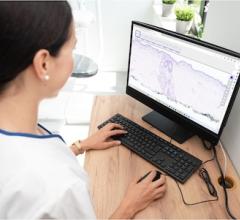
This bar graph shows breast cancer presentation by screening interval. Image courtesy of study author and RSNA
November 28, 2019 — Cancers found in patients undergoing annual mammography screening are smaller and less advanced than those found in patients undergoing screenings every two years, according to a new study presented next week at the annual meeting of the Radiological Society of North America (RSNA).
Breast cancer is the most common non-skin cancer among women in the United States, according to the Centers for Disease Control and Prevention. It is the most common cause of death from cancer among Hispanic women, and the second most common cause of death from cancer among white and black women.
Mammography screening has helped reduce mortality from breast cancer by providing detection of cancer in its earliest stages, when treatment is more likely to be effective. Mammography's value is widely accepted among professional societies and government agencies, but there is disagreement regarding how often women should get a screening mammogram. For instance, the National Comprehensive Cancer Network recommends annual screening beginning at age 40 for women at average risk for breast cancer, while the U.S. Preventive Services Task Force says screening every two years beginning at age 50 is sufficient for most women.
"These differing recommendations lead to confusion for both referring physicians and patients," said study co-author Sarah Moorman, M.D., from the Department of Radiology at Michigan Medicine in Ann Arbor, Mich.
Moorman and colleagues recently compared breast cancer tumor characteristics and treatment regimens among women undergoing annual mammography versus those getting biennial (every two years) screening. The study group included 232 women, ages 40 to 84, who were diagnosed with breast cancer. The two groups had no significant differences in baseline characteristics such as age, menopausal status, hormone replacement use, family history and race.
Of the 232 women, 200 or 86 percent, underwent annual screening, defined as once every nine to 15 months, while the remaining 32 had biennial screening, or once every 21 to 27 months. Mean age at cancer diagnosis among 232 patients was 62. Almost three-quarters of the cancers were invasive.
Almost half of women in the biennial screening group (14/32; 43.8 percent) had late-stage cancers, compared with only a quarter of women in the annual screening group (48/200; 24 percent). Interval cancers, or cancers found between screenings, were more prevalent in the biennial screening group. More than a third of those women had interval cancers, compared with only 10.5 percent of women who had annual screening. Biennial screening was associated with larger tumor size.
"Screening mammography performed once a year resulted in less advanced stage disease in patients diagnosed with breast cancer," Moorman said.
The study also found that women who had biennial screening tended to have more aggressive treatment, such as chemotherapy and dissection of the axillary lymph nodes, where cancer from the breast often spreads.
"There were trends toward less frequent axillary lymph node dissection and less frequent use of chemotherapy with annual screening compared with biennial screening," Moorman said.
Moorman hopes the findings of the study will help allow informed decision-making regarding screening frequency.
For more information: www.rsna.org
Related Content:
VIDEO: Women Benefit From Mammography Screening Beyond Age 75
VIDEO: How Contrast-Enhanced Mammography Will Impact Breast Imaging


 November 21, 2025
November 21, 2025 








